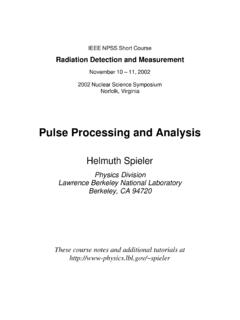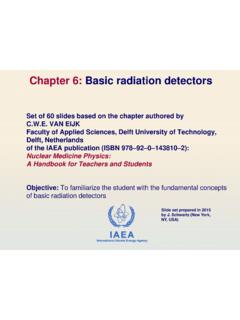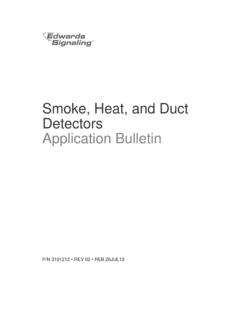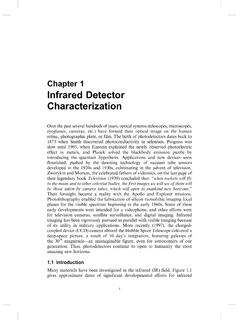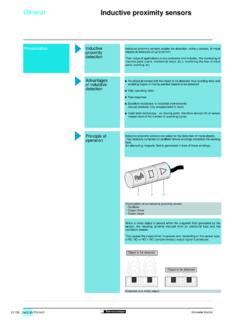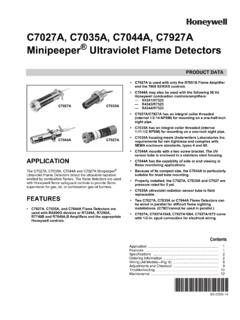Transcription of III. Scintillation Detectors
1 Introduction to Radiation Detectors and ElectronicsCopyright 1998 by Helmuth SpielerIII. Scintillation DetectorsIII. Scintillation Birks, The Theory and Practice of Scintillation Counting,New York, Knoll, Radiation Detection and Measurement,New York, Derenzo, Scintillation Counters, Photodetectors andRadiation Spectroscopy, IEEE Short Course RadiationDetection and Measurement, 1997 Nuclear Science Symp. Incident particles or photons excite atoms or molecules in thescintillating medium. Excited states decay under emission of photons, which aredetected and converted into electric Scintillation materialsBoth organic and inorganic materials,can be solid , liquid or gaseousa) organic scintillators ( plastics) states of interest are energy levels of individualmolecules, no interactions with neighbors excitation and emission spectra practically the samewhether in solid , liquid or gaseous to Radiation Detectors and ElectronicsCopyright 1998 by Helmuth SpielerIII.
2 Scintillation DetectorsTypical energy levels(from Birks, as redrawn by Derenzo)a)At room temperature practically all electrons in ground state.(since energy of S1 states >> eV)b)Incident radiation populates S1 statesvibrational levels within S1 band decay radiation-less toS1 base state, which in turn decays under emission oflight to the S0 )S1 can also decay to adjacent triplet their energy is significantly lower, the decay time is to Radiation Detectors and ElectronicsCopyright 1998 by Helmuth SpielerIII. Scintillation DetectorsWhy isn t emitted light re-absorbed?Since excitation goes to higher vibrational states in the S1band, whereas decay goes from the base S1 state, theemission spectrum is shifted to lower energies (longerwavelengths).
3 Only small overlap of emission and absorption spectraIntroduction to Radiation Detectors and ElectronicsCopyright 1998 by Helmuth SpielerIII. Scintillation DetectorsTime dependence of emitted lighta) non-radiative transfer of energy from vibrational states tofluorescent statetypical nsb) decay of fluorescent statetypical time:1 3 ns rise with time constant rfall with time constant ftotal pulse shapeRise time usually increased substantially by subsequentcomponents in system and variations in path length in ()/ 1 Itetf()/ ItIeettfr()()//= 0 Introduction to Radiation Detectors and ElectronicsCopyright 1998 by Helmuth SpielerIII.
4 Scintillation DetectorsProperties of some typical organic scintillatorsMaterialState max [nm] f [ns] [g/cm3] . 104 Pilot .. 104 Introduction to Radiation Detectors and ElectronicsCopyright 1998 by Helmuth SpielerIII. Scintillation DetectorsBoth the light output and the decay time of organicscintillators depend on the ionization time in stilbene for various particles(from Bollinger and Thomas)Introduction to Radiation Detectors and ElectronicsCopyright 1998 by Helmuth SpielerIII. Scintillation DetectorsLight yield vs. ionization density(Craun and Smith)(Blanc et al.)Introduction to Radiation Detectors and ElectronicsCopyright 1998 by Helmuth SpielerIII.
5 Scintillation DetectorsVariation of specific fluorescence dL/dx in anthracene withspecific energy loss dE/dx (Brooks, from Birks)Introduction to Radiation Detectors and ElectronicsCopyright 1998 by Helmuth SpielerIII. Scintillation DetectorsBirk s RuleFor an ideal scintillator and low ionization densityLuminescence Energy dissipated in scintillatoror, in differential formThe specific density of ionized and excited molecules along theparticle track isAssume that a portion of the primary excitation is lost at highionization density (ionization quenching) and introduce a quenchingparameter k. ThenFor small dE/dr this yields the luminescence yield postulated large dE/dr the specific luminescence saturates, as indicated bythe + 1dLdrSkBconst==Introduction to Radiation Detectors and ElectronicsCopyright 1998 by Helmuth SpielerIII.
6 Scintillation DetectorsThe dependence of decay time on ionization densitycan be used for particle example, by utilizing a pulse shaping network that makes thetiming of the output pulse dependent on decay time, the particledistribution is transformed into a time distribution that can bedigitized :n- discriminationP. Sperr, H. Spieler, Maier, NIM 116(1974)55 Introduction to Radiation Detectors and ElectronicsCopyright 1998 by Helmuth SpielerIII. Scintillation DetectorsInorganic ScintillatorsBand structure in inorganic crystalsIf forbidden band >> kT, no electrons in conduction band. InsulatorRadiation excites electron from valence into conduction band, formingan electron-hole in conduction band and holes in valence band can movefreely throughout to Radiation Detectors and ElectronicsCopyright 1998 by Helmuth SpielerIII.
7 Scintillation DetectorsFor light emission, one must introduce states into the forbidden band,so thatEemission < EgThree mechanisms:a)excitons (bound electron-hole pair)b)defects(interstitial atoms, for example induced by heat treatment)c)activators(from Derenzo)Examples:cooled NaI:h+ + e- exciton phonons + photonNaI(Tl):h+ + Tl+ Tl2+e- + Tl2+ (Tl+)*e- + Tl+ Tl0h+ + Tl0 (Tl+)*(Tl+)* Tl+ + phonons + photonIntroduction to Radiation Detectors and ElectronicsCopyright 1998 by Helmuth SpielerIII. Scintillation DetectorsLuminescence vs Quenching(from Birks)Excitation:A C(very fast)thermal equilibration:C B(~105 longer)Photon emission:B Dthermal equilibration:D AIf excited electron reaches F (depending on population of states inminimum B), the transitionF F1can proceed by phonon emission (lattice vibrations), without emission of a photon (quenching)In some crystals, the proximity region F-F1 is very close to theminimum of the excited state.
8 These crystals are heavily to Radiation Detectors and ElectronicsCopyright 1998 by Helmuth SpielerIII. Scintillation DetectorsOverlap of absorption and emission spectra(from Birks)Width of absorption and emission spectra depend on population ofstates in the respective minima A and and B must be sufficiently separated to yield adequate Stokes high temperatures the absorption and emission bands broaden,increasing the overlap and the fraction of luminescence photons lostto to Radiation Detectors and ElectronicsCopyright 1998 by Helmuth SpielerIII. Scintillation DetectorsSummary of practical inorganic scintillator materials(from Derenzo) max f PhotonsMaterial Form (nm) (ns) (g/cm3) per MeVNaI(Tl) (20 C) ,000pure NaI (-196 C) ,000Bi4Ge3O12 (20 C) ,200Bi4Ge3O12 (-100 C) ,000 CsI(Na) ,000 CsI(Tl) ,000 CsI (pure) , ,500 BaF2 (slow) ,000 BaF2 (fast) ,800Gd2 SiO5(Ce) , , , ,400 PbWO4crystal460 2, 10, (Ce) ,000 YAIO3(Ce) ,700Y2 SiO5(Ce) ,000 Note the wide range of decay times f , from ns in BaF2 to 15 sin materials also show multiple emissions (BaF2, PbWO4).
9 Introduction to Radiation Detectors and ElectronicsCopyright 1998 by Helmuth SpielerIII. Scintillation DetectorsScintillators with Tl, Bi, etc. decay slowly due to forbidden transitionsto the ground state:(from Derenzo)Introduction to Radiation Detectors and ElectronicsCopyright 1998 by Helmuth SpielerIII. Scintillation DetectorsThe very fast transitions in BaF2 and CsF are due to an intermediatetransition between the valence and core < Egfast fluorescenceEvv > Egemission of Auger electron(energy released in the transition from thevalence to the core band does not go intophoton emission, but into emission of an electronto the conduction band)Competition between photon emission and Auger effect narrows therange of scintillators with fast decays:If Evv is low:longer wavelength emission, longer decay timeIf Evv is high.
10 Auger emission, no Scintillation lightIntroduction to Radiation Detectors and ElectronicsCopyright 1998 by Helmuth SpielerIII. Scintillation DetectorsConversion of Scintillation Light to Electrical SignalMost Common Device:Photomultiplier Tube(from Photomultiplier Tubes, Philips Photonics)Introduction to Radiation Detectors and ElectronicsCopyright 1998 by Helmuth SpielerIII. Scintillation DetectorsPhotocathodesBand structure in standard photocathodeBand structure in negative electron affinity photocathode (from Photomultiplier Handbook, Burle Industries)Introduction to Radiation Detectors and ElectronicsCopyright 1998 by Helmuth SpielerIII.


